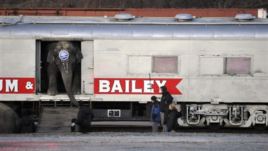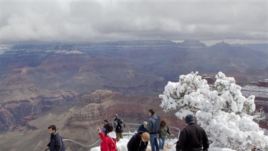SHIRLEY GRIFFITH: Welcome to THIS IS AMERICA in VOA Special English. I'm Shirley Griffith.
JUNE SIMMS: And I'm June Simms. This week on our program, we take you on a circus train. Then, we take a trip to one of America's most breathtaking natural wonders – the Grand Canyon.
(MUSIC)
SHIRLEY GRIFFITH: Ringling Brothers and Barnum & Bailey Circus is America's longest-running circus company. It began performances in the early 1890s and calls itself "The Greatest Show on Earth." More than a century later, the company continues many of the traditions of the early circus. One of those traditions is traveling by train. Ringling Brothers has two circus trains that are home to two different groups of performers.

Ringmaster Jonathan Iverson is a former opera singer. He joined the circus about ten years ago. He says the history of the company appealed to him.
JONATHAN IVERSON: "Part of that mystique is the world's largest privately owned train. I love the train. Three hundred performers and cast and crew and animals are actually traveling on rails across America. That is the world's greatest car pool."
JUNE SIMMS: A car pool is when a group of people share a ride together, like car pooling to work. The difference with the circus performers is they live in their car pool. And instead of just one car, there are more than 60 of them. The train is over a kilometer and a half long. It travels the country for 11 months a year.
Families can cook, shower, wash their clothes and live their lives in the privacy of their own cars. Jonathan Iverson is married to a dancer in the show. They share their train car with their two children.
JONATHAN IVERSON: "It is so much fun. It gives us sort of like a mini-vacation every week. We really see the country. America is really, really beautiful."
Alex Barney is a second-generation clown and he agrees.
ALEX BARNEY: "Traveling by the train, you are going through the middle of nowhere getting to the cities, you get to see what is left of the country. Definitely traveling by train is the key highlight for this job."
SHIRLEY GRIFFITH: In the middle of the 32 family coaches is the Pie Car. It has a kitchen and a dining area. The Pie Car is a social center for the train's long, traveling community.
Michael Vaughan is the circus chef. He and his six-person staff are responsible for meals. He says the job is like feeding a big family.
MICHAEL VAUGHAN: "Everybody here works together, all the groups -- clowns, the globe riders, everybody. We work together as a family."
Mr. Vaughan sets up another kitchen at each performance stop, and often throws a party after the show.
JUNE SIMMS: Education is also part of the traveling circus community. While the parents perform, the children learn in a classroom set up behind the activity. Manna Kettles is the teacher.
MANNA KETTLES: "My experience working here with Ringling, in the past, I have seen that they are better off than some of the kids in the regular schools because we get more time with them in a small group and we are able to work one-on-one with them."
Seven-year-old Sofia Petrov is from Hungary. She says she likes the circus school.
SOFIA PETROV: "It is fun. I get to meet a lot of new people from all over the world."
The newest Ringling Brothers show is called "Dragons." "Dragons" is the company's 142nd show. It brings together talent from 18 countries. Acrobat Paulo Dos Santos is from Brazil. He recently celebrated the birthday of his two sons before the show.
PAULO DOS SANTOS: "This moment is so good because everybody is coming. I am so happy because I see, you see I have friends here and my children too. We stay together, party together, show together, everything."
At each stop, the performers and their families get a chance to go into town and explore. They travel locally either by bus or in their own cars, which are also carried on the train.
One day there might be a chance to have fun at an amusement park, like Hershey Park in Pennsylvania. Another day they might explore a landmark like the Grand Canyon in Arizona. For ringmaster Jonathan Iverson, the circus train is like a city without a postal code.
JONATHAN IVERSON: "This is home. The backyard changes. Today's backyard has Hershey Park. Tomorrow's backyard has the Grand Canyon. That is the magic of it. But we are always home no matter where we are, we are always home."
(MUSIC)
SHIRLEY GRIFFITH: This Monday, the United States observes Memorial Day, honoring all those who have died in military service. The holiday is marked with ceremonies and community parades. Most government offices are closed.
The long Memorial Day weekend also marks the traditional start of the summer travel season. That means millions of Americans are on the road, many of them visiting popular sites, like the Grand Canyon in Arizona.

JUNE SIMMS: The Grand Canyon is one of the world's largest canyons -- 450 kilometers across. The surrounding land seems to hide the existence of such a great opening in the earth. You come upon the canyon suddenly, when you reach the edge.
SHIRLEY GRIFFITH: In some places, the canyon walls are more than a kilometer deep. Far below is the dark, twisting line of the Colorado River.
On the other side, sunshine lights up the rock walls in red, orange and gold. The bright colors are the result of minerals in the rocks. Their appearance changes endlessly -- with the light, the time of year and the weather. At sunset, when the sun has moved across the sky, the canyon walls give up their fiery reds and golds. They take on quieter colors of blue, purple, and green.
(MUSIC)
JUNE SIMMS: Hundreds of rocky points rise from the bottom of the Grand Canyon. Some are very tall.
Looking at the Grand Canyon is like looking back in time. Forty million years ago, the Colorado River began cutting through the area. At the same time, the surrounding land was pushed up by forces deep within the earth. Rain, snow, ice, wind and plant roots rubbed away at the top of the new canyon. Below, the flowing river continued to uncover more and more levels of ancient rock.
Some of Earth's oldest rocks can be found here. There are many levels of granite, schist, limestone and sandstone.
SHIRLEY GRIFFITH: Three thousand years ago, American Indians occupied the Grand Canyon. Evidence of their existence has been found in many places. Bones, hair, feathers and the remains of plants have been found in deep, dry caves high in the rock walls.
The Hopi, the Paiute, the Navajo and other Native American tribes have all been in the area for at least seven centuries. However, much of what we know today about the Grand Canyon was recorded by John Wesley Powell. In 1869, he became the first known white American to explore much of the canyon.
(MUSIC)
JUNE SIMMS: Today, the Grand Canyon is known as one of the seven wonders of the natural world. About five million people visit the canyon each year. Most visitors walk along paths, part way down into the canyon. It takes several hours to walk to the bottom. It takes twice as long to get back up to the top. Some visitors ride mules to the bottom and back.
SHIRLEY GRIFFITH: The National Park Service is responsible for protecting the Grand Canyon. Visitors are not supposed to leave any trash in the canyon or remove any rocks, plants or historical objects. As the Park Service tells visitors: "Take only photographs. Leave only footprints."
There are helicopter and airplane rides available for visitors to the Grand Canyon. Some visitors see the canyon by taking a boat trip along the Colorado River.
JUNE SIMMS: And there is still another way to see the Grand Canyon. A glass walkway called the Skywalk extends 21 meters from the edge. The Skywalk is suspended more than 1,200 meters above the bottom of the canyon. Visitors pay to walk along the glass walkway which is shaped like a giant horseshoe.
The Hualapai Indian Tribe built the Skywalk at a cost of more than 40 million dollars. The tribe owns almost 400,000 hectares of land in the canyon. Some people consider the Skywalk an engineering wonder. Others, however, have criticized the Skywalk and plans by the tribe for future development in the area. They say it harms a national treasure and reduces the enjoyment of one of nature's greatest wonders.
(MUSIC)
SHIRLEY GRIFFITH: Our program was produced by Brianna Blake, with reporting by June Soh. I'm Shirley Griffith.
JUNE SIMMS: And I'm-------- June Simms. You can find a video about the Ringling Brothers circus train on our website, voaspecialenglish.com. You can also find transcripts and MP3s of our programs, along with podcasts and activities for learning English. Join us again next week for THIS IS AMERICA in VOA Special English.
schist: 片巖
limestone: 石灰?guī)r
US National Park attendance declines
Montana man's not too old to clown around
(來(lái)源:VOA 編輯:旭燕)
